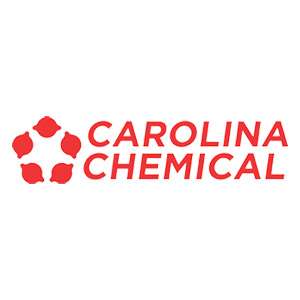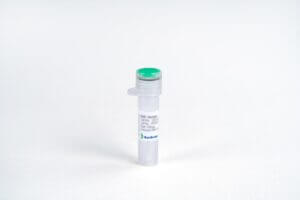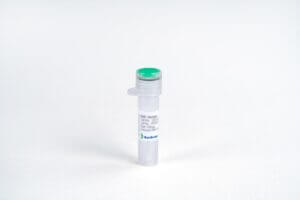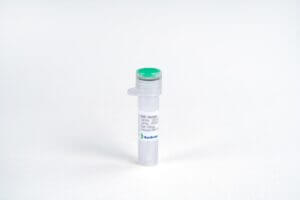10g
Showing 1301–1350 of 1780 results
-

Finasteride Powder – 10G
$81.88 Add to cart View Product DetailsCAS Number 98319-26-7 Molecular Weight 372.54Molecular Formula C23H36N2O2 -

Fladrafinil Powder – 10G
$65.00 Add to cart View Product DetailsCAS Number 90212-80-9 Molecular Weight 325.33 Molecular Formula C15H13F2NO3S -

Flt-3L, His, Mouse
$94.88 Add to cart View Product DetailsFlt3L, also known as Fms-related tyrosine kinase 3 ligand and SL cytokine, is a single-pass type I membrane protein. It is expressed by stromal cells and T cells. Flt3L signals through tyrosine kinase receptor Flt3/Flk2 to stimulate the proliferation of early hematopoietic progenitor cells. It synergizes with other growth factors, such as GM-CSF, IL-3 and CSF, to promote the differentiation of both myeloid and lymphoid cells. Alternative splicing and proteolytic cleavage of membrane-bound Flt3L generates a soluble extracellular domain (ECD) isoform with full biological activity.
-

Flt-3L, Human
$86.25 Add to cart View Product DetailsFms-related tyrosine kinase 3 ligand (Flt3L) is growth fator stimulates the proliferation and differentiation of hematopoietic multipotent progenitors and promotes proliferation of NK cells and dendritic cell subgroups by combination with other growth factors. Flt3L is produced by T cells and stromal fibroblasts, and targeted various cells including hematopoietic stem cells, B cells, T cells, dendritic cells, and NK cells. Flt3L binds to it cognate tyrosine kinase receptor Flt3 and activates JAK/STAT signaling pathway.Flt3L is a hematopoietic four helical bundle cytokine with structurally homologous to stem cell factor (SCF) and colony stimulating facor 1 (CSF-1) demonstrated four conserved cysteines and two glycosylation sites. Flt3L naturally as a non-disulfide-linked homodimer with multiple isoforms. The extracellular portion is approximately 160 amino acid residues in length and the cytoplasmic segment is approximately 20-30 amino acid residues in length.
-

Fmoc-Glu(OtBu)-OH, 97+ Percent
$74.24 Add to cart View Product DetailsFmoc-Glu(OtBu)-OH, 97+ Percent
-

Folic Acid, Powder, USP
$97.16 Add to cart View Product DetailsFolic Acid, Powder, USP
-

G-CSF, Human
$76.76 Add to cart View Product DetailsGranulocyte Colony-Stimulating Factor (G-CSF) contains internal disulfide bonds. Among the family of colony-stimulating factors, Granulocyte Colony Stimulating Factor (G-CSF) is the most potent inducer of terminal differentiation to granulocytes and macrophages of leukemic myeloid cell lines. The synthesis of Granulocyte Colony Stimulating Factor (G-CSF) can be induced by bacterial endotoxins, TNF, Interleukin-1 and GM-CSF. Prostaglandin E2 inhibits the synthesis of Granulocyte Colony Stimulating Factor (G-CSF). In epithelial, endothelial, and fibroblastic cells secretion of Granulocyte Colony Stimulating Factor (G-CSF) is induced by Interleukin-17.
-

G-CSF, Human(CHO-expressed)
$86.25 Add to cart View Product DetailsHuman Granulocyte Colony Stimulating Factor (G-CSF) contains internal disulfide bonds. Among the family of colony-stimulating factors, Granulocyte Colony Stimulating Factor (G-CSF) is the most potent inducer of terminal differentiation to granulocytes and macrophages of leukemic myeloid cell lines. The synthesis of Granulocyte Colony Stimulating Factor (G-CSF) can be induced by bacterial endotoxins, TNF, Interleukin-1 and GM-CSF. Prostaglandin E2 inhibits the synthesis of Granulocyte Colony Stimulating Factor (G-CSF). In epithelial, endothelial, and fibroblastic cells, the secretion of Granulocyte Colony Stimulating Factor (G-CSF) is induced by Interleukin-17.
-

G-CSF, Mouse
$86.25 Add to cart View Product DetailsGranulocyte Colony-Stimulating Factor (G-CSF), also known as CSF-3 and MGI-1G, is a cytokine and hormone belonging to the IL-6 superfamily. It is expressed by monocytes, macrophages, endothelial cells, fibroblasts and bone marrow stroma. G-CSF stimulates the bone marrow to produce granulocytes and stem cells, and specifically stimulates the proliferation and differentiation of the neutrophilic granulocyte lineage. G-CSF has been used to stimulate white blood cell production after chemotherapy. It has also been used to boost the number of hematopoietic stem cells after bone marrow transplantation.
-

gAcrp30/Adipolean, Mouse
$68.14 Add to cart View Product DetailsgAcrp30 is the globular head domain of Adipocyte complement-related protein of 30 kDa (Acrp30), a cytokine expressed in adipocytes. The name of Acrp30 is bases on its closest homolog, complement factor c1q, and the globular domain of Acrp30 has an unexpected homology with the Tumor Necrosis Factor (TNF) family of cytokines. Acrp30 is recognized by two receptors: adipoR1 expressed in skeletal muscle, and adipoR2 expressed in liver. The expression level of Acrp30 in adipocytes is negatively correlated with body weight and is lower in obese mouse than normal mouse. The globular domain of Acrp30 induces free fatty acid oxidation in muscle and weight reduction in mouse, suggesting its potential use as a pharmacological agent in obesity.
-

gamma-Butyrobetaine Hydrochloride
$1,539.56 Add to cart View Product DetailsMolecular Formula : C7 H16 N O2 . Cl
-

GDNF, Human
$86.25 Add to cart View Product DetailsGlial cell line-derived neurotrophic factor (GDNF) is a neurotrophic factor belonging to the TGF-beta super family and is necessary for neuron survival and phenotypic maintenance in the central and peripheral nervous systems. G-DNF has the potential to support the differentiation and survival of many neuron subpopulations, especially dopaminergic neurons and motor neurons, as well as Purkinje cells and sympathetic neurons. Sertoli cells, type 1 astrocytes, Schwann cells, neurons, pinealocytes and skeletal muscle cells are known to express GDNF in human. GDNF has been shown to interact with GFRA2 and GDNF family receptor alpha 1. Mutations in this gene may be associated with Hirschsprung’s disease, Parkinson’s disease and amyotrophic lateral sclerosis (ALS).The recombinant human G-DNF expressed in E.coli is a disulfide-linked homo-dimer, with an apparent molecular weight of 17 kDa.
-

Gentamicin Sulfate
$100.75 Add to cart View Product DetailsGentamicin Sulfate
-

GH, Human
$34.50 Add to cart View Product DetailsGrowth Hormone (GH) is a member of the somatotropin/prolactin family which play an important role in growth control. The human GH cDNA encodes a 217 amino acid (aa), and the first 26 aa is a signal peptide. By alternative splicing, at least four isoforms of GH have been identified. The major role of GH in stimulating body growth is to stimulate the liver and other tissues to secrete IGF-1. GH stimulates both the differentiation and proliferation of myoblasts, and also stimulates amino acid uptake and protein synthesis in muscle and other tissues.
-

GH, Human(CHO-expressed)
$76.76 Add to cart View Product DetailsGrowth Hormone (GH) is a member of the somatotropin/prolactin family which play an important role in growth control. The human GH cDNA encodes a 217 amino acid (aa), and the first 26 aa is a signal peptide. By alternative splicing, at least four isoforms of GH have been identified. The major role of GH in stimulating body growth is to stimulate the liver and other tissues to secrete IGF-1. GH stimulates both the differentiation and proliferation of myoblasts, and also stimulates amino acid uptake and protein synthesis in muscle and other tissues.
-

GH, Mouse
$76.76 Add to cart View Product DetailsGrowth Hormone (GH), is a member of the somatotropin / prolactin family of hormones which play an important role in growth control. The gene, along with four other related genes, is located at the growth hormone locus on chromosome 17 where they are interspersed in the same transcriptional orientation; an arrangement which is thought to have evolved by a series of gene duplications. The five genes share a remarkably high degree of sequence identity. Alternative splicing generates additional isoforms of each of the five growth hormones, leading to further diversity and potential for specialization. This particular family member is expressed in the pituitary but not in placental tissue as is the case for the other four genes in the growth hormone locus. Mutations in or deletions of the gene lead to growth hormone deficiency and short stature.
-

Giemsa Stain
$238.22 Add to cart View Product DetailsGiemsa Stain
-

Glutathione reduced form
$75.70 Add to cart View Product DetailsGlutathione reduced form
-
![Glycerol, [Matrix for FABMS and liquid SIMS]](https://advatechgroup.com/wp-content/plugins/woocommerce/assets/images/xplaceholder.webp.pagespeed.ic.ANHCL-f_RA.webp)
Glycerol, [Matrix for FABMS and liquid SIMS]
$138.79 Add to cart View Product DetailsGlycerol, [Matrix for FABMS and liquid SIMS]
-

Glycochenodeoxycholic Acid Sodium Salt
$3,414.99 Add to cart View Product DetailsGlycochenodeoxycholic Acid Sodium Salt
-

GM-CSF, Human
$86.25 Add to cart View Product DetailsGranulocyte Macrophage-Colony Stimulating Factor (GM-CSF) was initially characterized as a growth factor that can support the in vitro colony formation of granulocyte-macrophage progenitors. Granulocyte Macrophage-Colony Stimulating Factor (GM-CSF) is produced by a number of different cell types, including activated T cells, B cells, macrophages, mast cells, endothelial cells, and fibroblasts, in response to cytokine of immune and inflammatory stimuli. Besides granulocyte-macrophage progenitors, Granulocyte Macrophage-Colony Stimulating Factor (GM-CSF) is a growth factor for erythroid, megakaryocyte, and eosinophil progenitors. On mature hematopoietic, monocytes/macrophages and eosinophils. Human Granulocyte Macrophage-Colony Stimulating Factor (GM-CSF) can induce human endothelial cells to migrate and proliferate. Additionally, Granulocyte Macrophage-Colony Stimulating Factor (GM-CSF) can stimulate the proliferation of a number of tumor cell lines, including osteogenic sarcoma, carcinoma, and adenocarcinoma cell lines.
-

GM-CSF, Human(CHO-expressed)
$86.25 Add to cart View Product DetailsGranulocyte Macrophage-Colony Stimulating Factor (GM-CSF) was initially characterized as a growth factor that can support the in vitro colony formation of granulocyte-macrophage progenitors. Granulocyte Macrophage-Colony Stimulating Factor (GM-CSF) is produced by a number of different cell types, including activated T cells, B cells, macrophages, mast cells, endothelial cells, and fibroblasts, in response to cytokine of immune and inflammatory stimuli. Besides granulocyte-macrophage progenitors, Granulocyte Macrophage-Colony Stimulating Factor (GM-CSF) is a growth factor for erythroid, megakaryocyte, and eosinophil progenitors. On mature hematopoietic, monocytes/macrophages and eosinophils. Human Granulocyte Macrophage-Colony Stimulating Factor (GM-CSF) can induce human endothelial cells to migrate and proliferate. Additionally, Granulocyte Macrophage-Colony Stimulating Factor (GM-CSF) can stimulate the proliferation of a number of tumor cell lines, including osteogenic sarcoma, carcinoma, and adenocarcinoma cell lines.
-

GM-CSF, Mouse
$86.25 Add to cart View Product DetailsGranulocyte Macrophage-Colony Stimulating Factor (GM-CSF) was initially characterized as a growth factor that can support the in vitro colony formation of granulocyte-macrophage progenitors. Granulocyte Macrophage-Colony Stimulating Factor (GM-CSF) is produced by a number of different cell types, including activated T cells, B cells, macrophages, mast cells, endothelial cells, and fibroblasts, in response to cytokine of immune and inflammatory stimuli. Besides granulocyte-macrophage progenitors, Granulocyte Macrophage-Colony Stimulating Factor (GM-CSF) is a growth factor for erythroid, megakaryocyte, and eosinophil progenitors. On mature hematopoietic, monocytes/macrophages and eosinophils. Additionally, Granulocyte Macrophage-Colony Stimulating Factor (GM-CSF) can stimulate the proliferation of a number of tumor cell lines, including osteogenic sarcoma, carcinoma, and adenocarcinoma cell lines.
-

GM-CSF, Mouse
$68.14 Add to cart View Product DetailsGranulocyte Macrophage-Colony Stimulating Factor (GM-CSF) was initially characterized as a growth factor that can support the in vitro colony formation of granulocyte-macrophage progenitors. Granulocyte Macrophage-Colony Stimulating Factor (GM-CSF) is produced by a number of different cell types, including activated T cells, B cells, macrophages, mast cells, endothelial cells, and fibroblasts, in response to cytokine of immune and inflammatory stimuli. Besides granulocyte-macrophage progenitors, Granulocyte Macrophage-Colony Stimulating Factor (GM-CSF) is a growth factor for erythroid, megakaryocyte, and eosinophil progenitors. On mature hematopoietic, monocytes/macrophages and eosinophils. Additionally, Granulocyte Macrophage-Colony Stimulating Factor (GM-CSF) can stimulate the proliferation of a number of tumor cell lines, including osteogenic sarcoma, carcinoma, and adenocarcinoma cell lines.
-

GM-CSF, Rat
$68.14 Add to cart View Product DetailsGranulocyte Macrophage-Colony Stimulating Factor (GM-CSF) was initially characterized as a growth factor that can support the in vitro colony formation of granulocyte-macrophage progenitors. Granulocyte Macrophage-Colony Stimulating Factor (GM-CSF) is produced by a number of different cell types, including activated T cells, B cells, macrophages, mast cells, endothelial cells, and fibroblasts, in response to cytokine of immune and inflammatory stimuli. Besides granulocyte-macrophage progenitors, Granulocyte Macrophage-Colony Stimulating Factor (GM-CSF) is a growth factor for erythroid, megakaryocyte, and eosinophil progenitors. On mature hematopoietic, monocytes/macrophages and eosinophils. Additionally, Granulocyte Macrophage-Colony Stimulating Factor (GM-CSF) can stimulate the proliferation of a number of tumor cell lines, including osteogenic sarcoma, carcinoma, and adenocarcinoma cell lines.
-

GM-CSF, RhesusMacaque
$155.25 Add to cart View Product DetailsGranulocyte Macrophage-Colony Stimulating Factor (GM-CSF) was initially characterized as a growth factor that can support the in vitro colony formation of granulocyte-macrophage progenitors. Granulocyte Macrophage-Colony Stimulating Factor (GM-CSF) is produced by a number of different cell types, including activated T cells, B cells, macrophages, mast cells, endothelial cells, and fibroblasts, in response to cytokine of immune and inflammatory stimuli. Besides granulocyte-macrophage progenitors, Granulocyte Macrophage-Colony Stimulating Factor (GM-CSF) is a growth factor for erythroid, megakaryocyte, and eosinophil progenitors. On mature hematopoietic, monocytes/macrophages and eosinophils. Additionally, Granulocyte Macrophage-Colony Stimulating Factor (GM-CSF) can stimulate the proliferation of a number of tumor cell lines, including osteogenic sarcoma, carcinoma, and adenocarcinoma cell lines.
-

Gold Chloride, Trihydrate, Reagent, ACS
$1,816.71 Add to cart View Product DetailsGold Chloride, Trihydrate, Reagent, ACS
-

Gold Chloride, Trihydrate, Reagent, ACS
$7,502.45 Add to cart View Product DetailsGold Chloride, Trihydrate, Reagent, ACS
-

Gold Potassium Cyanide, Powder
$3,190.17 Add to cart View Product DetailsGold Potassium Cyanide, Powder
-

Guaiazulene
$88.33 Add to cart View Product DetailsGuaiazulene
-

H1N1 (A/California/04/2009), Hemagglutinin
$43.13 Add to cart View Product DetailsInfluenza hemagglutinin (HA) is a glycoprotein found on the surface of the influenzavirus. It is responsible for binding the virus to cells with sialic acid on their membranes, such as cells in the upper respiratory tract or erythrocytes. It is also responsible for the fusion of the viral envelope with the endosome membrane after the pH has been reduced. The name “hemagglutinin” comes from the protein’s ability to cause red blood cells (erythrocytes) to clump together in vitro. HA has two functions. First, it allows the recognition of target vertebrate cells, accomplished through binding to these cells’ sialic acid-containing receptors. Second, once bound it facilitates the entry of the viral genome into the target cells by causing the fusion of the host endosomal membrane with the viral membrane. H1N1 is a subtype of influenza virus A and the most common cause of influenza in humans.
-

HB-EGF, Human
$43.13 Add to cart View Product DetailsProheparin-binding EGF-like growth factor (HB-EGF), also known as DTR, DTS and HEGFL, is a member of the EGF family of mitogens. It is expressed in macrophages, monocytes, endothelial cells and muscle cells. HB-EGF signals through the EGF receptor to stimulate the proliferation of smooth muscle cells, epithelial cells and keratinocytes. Compared to EGF, HB-EGF binds to the EGF receptor with a higher affinity and has been shown to bemore mitogenic, likely due to its ability to bind to heparin and heparin sulfate proteoglycans. HB-EGF has also been reported to act as a diphtheria toxin receptor, mediating endocytosis of the bound toxin. Heparin-binding EGF-like growth factor has been shown to interact with NRD1, Zinc finger and BTB domain-containing protein 16 and BAG1.
-

HB-EGF, Human
$68.14 Add to cart View Product DetailsProheparin-binding EGF-like growth factor (HB-EGF), also known as DTR, DTS and HEGFL, is a member of the EGF family of mitogens. It is expressed in macrophages, monocytes, endothelial cells and muscle cells. HB-EGF signals through the EGF receptor to stimulate the proliferation of smooth muscle cells, epithelial cells and keratinocytes. Compared to EGF, HB-EGF binds to the EGF receptor with a higher affinity and has been shown to bemore mitogenic, likely due to its ability to bind to heparin and heparin sulfate proteoglycans. HB-EGF has also been reported to act as a diphtheria toxin receptor, mediating endocytosis of the bound toxin. Heparin-binding EGF-like growth factor has been shown to interact with NRD1, Zinc finger and BTB domain-containing protein 16 and BAG1.
-

HB-EGF, Mouse
$68.14 Add to cart View Product DetailsHeparin-binding EGF-like growth factor (HB-EGF) is a member of the EGF family of proteins. HB-EGF-like growth factor is synthesized as a membrane-anchored mitogenic and chemotactic glycoprotein. An epidermal growth factor produced by monocytes and macrophages, due to an affinity for heparin is termed HB-EGF. It has been shown to play a role in wound healing, cardiac hypertrophy and heart development and function. The transmembrane form of HB-EGF is the unique receptor for diptheria toxin and functions in juxtacrine signaling in cells. Both forms of HB-EGF participate in normal physiological processes and in pathological processes including tumor progression and metastasis, organ hyperplasia, and atherosclerotic disease. HB-EGF can bind two locations on cell surfaces, heparan sulfate proteoglycans and EGF-receptor effecting cell to cell interactions.
-

Heat Stable FGF-basic, Human
$86.25 Add to cart View Product DetailsHeat Stable FGF-basic, Human is a pleiotropic cytokine and one of the prototypic members of the heparin-binding FGF family. Like other FGF family members, FGF-basic has the β trefoil structure. In vivo, FGF-basic is produced by a variety of cells, including cardiomyocytes, fibroblasts, and vascular cells. FGF-basic regulates a variety of processes including cell proliferation, differentiation, survival, adhesion, motility, apoptosis, limb formation and wound healing. FGF-basic can be tumorigenic due to its role in angiogenesis and blood vessel remodeling. The angiogenic effects of FGF-basic can produce beneficial cardioprotection during acute heart injury.
-

Hematoxylin
$222.18 Add to cart View Product DetailsHematoxylin
-

Heregulin β-1, Human
$51.75 Add to cart View Product DetailsNeuregulins or neuroregulins are a family of four structurally related proteins (NRG1, NRG2, NRG3 and NRG4) that are members of the EGF family of proteins. Studies indicate neuregulins function in nervous system development with essential roles in vertebrate embryogenesis including: cardiac development, Schwann cell and oligodendrocyte differentiation, certain aspects of neuronal development, and the formation of neuromuscular synapses. Neuregulin 1 is essential for the normal development of the nervous system and the heart. It is produced in numerous isoforms by alternative splicing, allowing it to perform a variety of functions. All NRG1 isoforms contain an EGF-like domain that is required for direct binding to ErbB3 or ErbB4 receptor tyrosine kinases. The transmembrane NRG1 isoforms contain an extracellular domain that can be proteolytically cleaved to release soluble growth factors.
-

Hexadecanamide
$201.87 Add to cart View Product DetailsHexadecanamide
-

HGF, Human
$107.81 Add to cart View Product DetailsHepatocyte Growth Factor (HGF),also known as hepatopoietin-A and scatter factor, is a pleiotropic mitogen belonging to the peptidase S1 family (plasminogen subfamily). It is produced by mesenchymal cells and acts on epithelial cells, endothelial cells and haemopoietic progenitor cells. HGF binds to the proto-oncogenic c-Met receptor to activate a tyrosine kinase signaling cascade. It regulates cell growth, motility and morphogenesis, thus it plays a pivotal role in angiogenesis, tumorogenesis and tissue regeneration.
-

HRG1-β1, Human
$43.13 Add to cart View Product DetailsHeregulin1-Beta1(HRG1-Beta1) is one of the isoforms encoded by Neuregulin (NRG) genes. NRGs are synthesized as large transmembrane precursor proteins, and the NRG family has 4 members and 26 isoforms. These isoforms provide large diversities, including different tissue distribution, variable potencies, and different biological functions. HRG1-β1 belongs to Type I HRG1, and is expressed in neural tissue, respiratory epithelia, and heart. In vivo, HRG1 binds and activates both ErbB3 and ErbB4, the transmembrane receptor tyrosine kinase, and is involved in the proliferation, differentiation, and survival of cells. Aberrantly produced HRG1 could be used in the constitute activation of the ErbB receptors; therefore, the upregulation of HRG1 contributes to the development of tumors, including breast cancer.
-

Hydromorphone Hydrochloride (CII), USP
$3,462.59 Add to cart View Product DetailsHydromorphone Hydrochloride (CII), USP
-

Hydroxy Naphthol Blue
$99.95 Add to cart View Product DetailsHydroxy Naphthol Blue
-

IFN-α 1b, Human
$133.69 Add to cart View Product DetailsAt least 23 different variants of IFN-alpha are known. The individual proteins have molecular masses between 19-26 kDa and consist of proteins with lengths of 156-166 and 172 amino acids. All IFN-alpha subtypes possess a common conserved sequence region between amino acid positions 115-151 while the amino-terminal ends are variable. Many IFN-alpha subtypes differ in their sequences at only one or two positions. Naturally occurring variants also include proteins truncated by 10 amino acids at the carboxy-terminal end.
-

IFN-α 2a, Human
$36.23 Add to cart View Product DetailsInterferon-Alpha 2a (IFN-Alpha 2a), Human produced by leukocytes is a member of Interferon family. IFN-alpha is mainly involved in innate immune response against a broad range of viral infections. IFN-alpha 2 has three acid stable forms (a,b,c) signaling through IFNAR2. IFN-alpha 2a shares 99.4% , 98.8% aa sequence identity with IFN-alpha 2b and 2c respectively. IFN-alpha contains four highly conserved cysteine residues which form two disulfide bonds, one of which is necessary for biological activity.
-

IFN-α 2b, Human
$34.50 Add to cart View Product DetailsInterferon-Alpha 2b (IFN-Alpha 2b) produced by leukocytes is a member of Interferon family. IFN-alpha is mainly involved in innate immune response against a broad range of viral infections. IFN-alpha 2 has three acid stable forms (a,b,c) signaling through IFNAR2. IFN-alpha 2b shares 99.4% aa sequence identity with both IFN-alpha 2a and 2c. IFN-alpha contains four highly conserved cysteine residues which form two disulfide bonds, one of which is necessary for biological activity.
-

IFN-γ R II, Human
$63.83 Add to cart View Product DetailsIFN-gamma Receptor II, also known as IFNGR2 and IFNGT1, is a transmembrane protein belonging to the type II cytokine receptor family. IFNGR2 is a non-ligand-binding beta chain of the IFN-gamma receptor. It is an integral part of the IFN-gamma signaling transduction pathway and is likely to interact with GAF, JAK1 and JAK2. Defects in IFNGR2 are a cause of autosomal recessive Mendelian susceptibility to mycobacterial disease (MSMD), also known as familial disseminated atypical mycobacterial infection.
-

IFN-γ, Human
$34.50 Add to cart View Product DetailsHuman Interferon gamma (hIFN-γ) is amacrophage‐activating factor and the lone member of Interferon type II.The active form of IFN-γ is an antiparallel dimer that interacts with the receptor IFN-γR1 and sets off IFN-γ/JAK/STAT pathway. IFN-γ signaling does diverse biological functions primarily related to host defense and immune regulation, including antiviral and antibacterial defense, apoptosis, inflammation, and innate and acquired immunity. While IFN-γ–induced inflammatory cascade summons a variety of immune‐related cell types, such as macrophages, natural killer (NK) cells and cytotoxic T lymphocytes (CTLs), IFN-γ is also implicated in resistance to NK cell and CTL responses and in immune escape in a variety of cancers.
-

IFN-γ, Human(CHO-expressed)
$36.23 Add to cart View Product DetailsHuman Interferon gamma (hIFN-γ) is amacrophage-activating factor and the lone member of Interferon type II. The active form of IFN-γ is an antiparallel dimer that interacts with the receptor IFN-γR1 and sets off IFN-γ/JAK/STAT pathway. IFN-γ signaling does diverse biological functions primarily related to host defense and immune regulation, including antiviral and antibacterial defense, apoptosis, inflammation, and innate and acquired immunity. While IFN-γ–induced inflammatory cascade summons a variety of immune-related cell types, such as macrophages, natural killer (NK) cells and cytotoxic T lymphocytes (CTLs), IFN-γ is also implicated in resistance to NK cell and CTL responses and in immune escape in a variety of cancers.
-

IFN-γ, Rat (CHO-expressed)
$36.23 Add to cart View Product DetailsInterferon-γ (IFN-γ), also known as Type II interferon or immune interferon, is a cytokine produced primarily by T-lymphocytes and natural killer cells. The active form of IFN-γ is an antiparallel dimer that interacts with the receptor IFN-γR1 and sets off IFN-γ/JAK/STAT pathway. IFN-γ signaling does diverse biological functions primarily related to host defense and immune regulation, including antiviral and antibacterial defense, apoptosis, inflammation, and innate and acquired immunity. While IFN-γ–induced inflammatory cascade summons a variety of immune-related cell types, such as macrophages, natural killer (NK) cells and cytotoxic T lymphocytes (CTLs), IFN-γ is also implicated in resistance to NK cell and CTL responses and in immune escape in a variety of cancers.
-

IGF-BP-2, His, Human
$51.75 Add to cart View Product DetailsIGF-BP-2, also known as Insulin-like growth factor-binding protein 2, IBP-2 and BP-2, is a cysteine-rich secreted protein belonging to the IGF-binding protein superfamily. It is expressed by the central nervous system, bone cells and reproductive tissues. IGF-BP-2 binds to both IGF-I and IGF-II, with a much higher binding affinity to IGF-II than IGF-I. IGF-BP-2 has been shown to inhibitand stimulate the growth promoting effects of IGFs, thus serving as a regulator for IGF distribution, function and activity.






